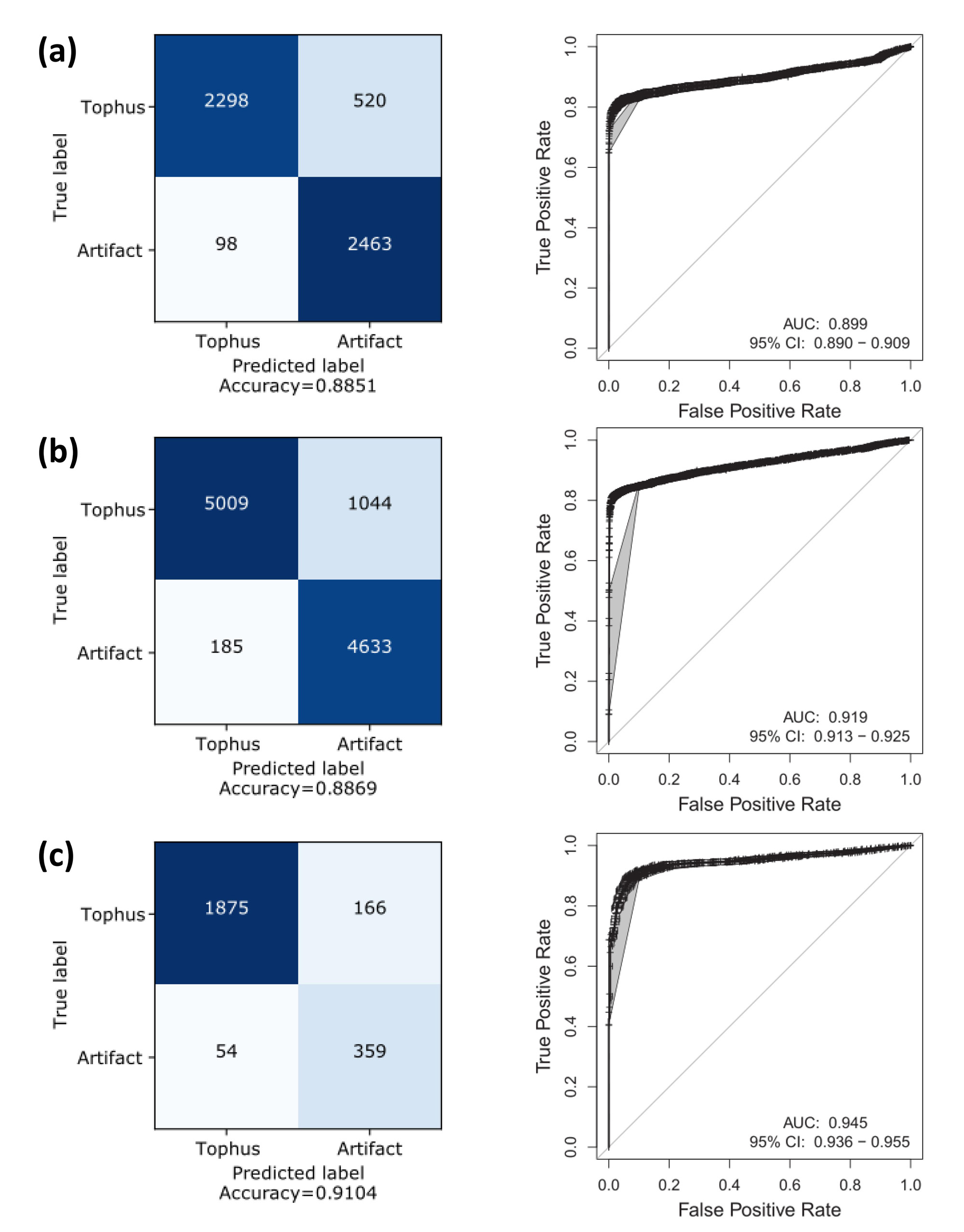Session Information
Session Type: Poster Session C
Session Time: 9:00AM-11:00AM
Background/Purpose: In a recent study, the low specificity of Dual-Energy CT (DECT) has raised concerns due to the frequent occurrence of pseudo lesions, also referred to as clumpy artifacts, result in inaccurate discrimination from true monosodium urate (MSU) crystals due to their small size and overlapping image findings. This clinical impact is significant since a positive image finding on DECT is assigned a score of four, which accounts for half of the threshold according to the 2015 EULAR/ACR classification guideline.
The objective of this study is to assess the efficacy and accuracy of machine learning algorithms in distinguishing pseudo lesion from true MSU crystals in DECT imaging.
Methods: This study presents a comprehensive analysis of 18,958 regions of interest (ROIs) extracted from the green color foci of Dual-energy CT (DECT) scans obtained from 47 individuals diagnosed with gout and 27 gout-free controls. The ROIs were meticulously categorized into three size groups: small (n=4,911), medium (n=11,419), and large (n=2,628). As we conducted our analysis, we employed a two-step approach for the classification of tophus/artifacts, both on a per-lesion basis and on a per-patient basis. For the per-lesion classification, a convolutional neural network (CNN) model based on the VGG16 architecture with Global Average Pooling (GAP) was utilized. This model was trained using a 6-fold cross-validation scheme, where the dataset was divided into six subsets. To perform the classification on a per-patient basis, a Support Vector Machine (SVM) approach was employed and trained five times using cross-validation training folds. The performance of the models was evaluated using area under the receiver operating characteristic curve, sensitivity, specificity, positive predictive value, and negative predictive value.
Results: The sensitivity and specificity of the deep learning algorithm, VGG16 with GAP, for different sizes of ROIs were as follows: for small-sized ROIs, the sensitivity was 81.5% (95% CI, 95.3-96.8%) with a specificity of 96.1% (95% CI, 95.3-96.8%); for medium-sized ROIs, the sensitivity was 82.7% (95% CI, 81.7-83.7%) with a specificity of 96.1% (95% CI, 95.5-96.6%); and for large-sized ROIs, the sensitivity was 91.8% (95% CI, 90.6-93.0%) with a specificity of 86.9% (95% CI, 83.2-90.0%). The DL algorithm exhibited accuracies of 88.5% for small-sized ROIs, 88.6% for medium-sized ROIs, and 91.0% for large-sized ROIs. In the per-patient analysis, the SVM approach demonstrated a sensitivity of 87.2%, a specificity of 100%, and an accuracy of 91.8% (95% CI, 83.1-96.9%) in distinguishing between patients with gout and gout-free controls.
Conclusion: By applying deep learning algorithms, DECT shows impressive diagnostic performance by distinguishing the green color foci of DECT scans from pseudo lesions and tophi, leading to enhanced specificity even with small-sized green color lesions. Deep learning algorithms offer comprehensible and unequivocal approaches in DECT, allowing for precise and unmistakable diagnoses of gout.
(a) In 3D DECT, there are pseudo lesions that appear as scattered green color foci at the hindfoot. Note that this patient obtains CT for fracture evaluation. (b) 3D DECT from gouty patients shows multiple patches of green color foci at the mid and hind foot. The green color from (a) and (b) are difficult to distinguish. (c) Final ROI labeling for deep learning.
The top pair (a) of matrices and curves corresponds to the classification model trained on the small-area dataset. The middle pair (b) represents the results for the medium-area dataset, while the bottom pair (c) displays the outcomes for the large-area dataset.
To cite this abstract in AMA style:
Yoo W, Park E, Lee D, Casto-Zunti R, Choi Y. Solving the Final Puzzle of Gout Detection in DECT via Machine Learning-Based Mitigation of Pseudolesion-Related Challenges: Enhancing Diagnostic Accuracy [abstract]. Arthritis Rheumatol. 2023; 75 (suppl 9). https://acrabstracts.org/abstract/solving-the-final-puzzle-of-gout-detection-in-dect-via-machine-learning-based-mitigation-of-pseudolesion-related-challenges-enhancing-diagnostic-accuracy/. Accessed .« Back to ACR Convergence 2023
ACR Meeting Abstracts - https://acrabstracts.org/abstract/solving-the-final-puzzle-of-gout-detection-in-dect-via-machine-learning-based-mitigation-of-pseudolesion-related-challenges-enhancing-diagnostic-accuracy/



